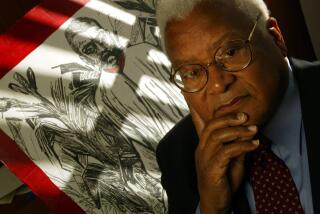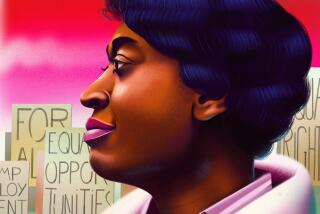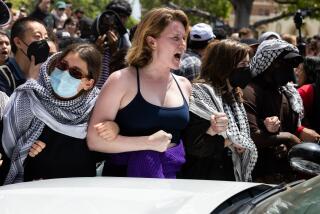The sit-ins that changed America
The “sixties” were born on Feb. 1, 1960, 50 years ago this week, when four African American college students staged the first sit-in at a segregated lunch counter in Greensboro, N.C. Since then, the mythology of the ‘60s has dominated the idea of youthful activism.
Of the three big events of the early civil rights movement -- the 1954 Brown vs. Board of Education decision, the 1955-56 Montgomery bus boycott and the sit-ins -- the sit-ins have always been the least understood and, yet, the most important for today’s young activists.
We forget how troubled the civil rights movement was in January 1960. It was six years after Brown, but fewer than 1 in 100 black students in the South attended an integrated school. And during the four years after the end of the bus boycott, Martin Luther King Jr. struggled to build on that victory. Many worried that the civil rights movement had ground to a halt. Then Greensboro changed everything.
In the time before Twitter, the rapid spread of the sit-ins was shocking. The first sit-in was an impulsive act, led by college students. They spread to Nashville, Atlanta, Miami, Durham, N.C., and Little Rock, Ark. -- more than 70 cities and towns in eight weeks. By summer, more than 50,000 people had taken part in one.
At the time, this was not just the largest black protest against segregation ever; it was the largest outburst of civil disobedience in American history. The sit-ins rewrote the rules of protest. They were remarkably egalitarian: Everyone participated; everyone was in equal danger. And they went viral because they were easy to copy. All one needed for a sit-in was some friends and a commitment to a few simple principles of nonviolent protest.
Most important, the sit-ins were designed to highlight the immorality of segregation by forcing Southern policemen to arrest polite, well-dressed college students sitting quietly just trying to order a shake or a burger. The students believed deeply in Thoreau’s idea that the only place for a just person in an unjust society is jail.
The contrast with King’s early efforts was stark. He had worked hard during the bus boycott to prevent arrests. To his thinking, only protests that remained within the bounds of the law could win the war against Jim Crow. The NAACP similarly believed in the power of the courts to end school segregation. But such efforts were so bureaucratic that ordinary African Americans often felt more like observers than participants.
To their African American contemporaries, the college students seemed the unlikeliest group to revive the civil rights movement. Just three years earlier, E. Franklin Frazier, the eminent black sociologist, had condemned them for believing that “money and conspicuous consumption are more important than knowledge.” What did Frazier miss?
He failed to see how the comfort of postwar affluence and popular culture bred agitation and activism as easily as it did indifference and apathy. The sit-ins owed more to Little Richard and Levi’s than to Jesus and the Bible.
Youth culture in the ‘50s often made it seem that generation mattered more than race. After all, weren’t African American couples sharing the dance floor with white ones on the hit teen show “American Bandstand”? Yet, in their everyday lives, black teens still felt the sting of segregation. The first thing the Greensboro Four did before starting their sit-in at Woolworth’s was to purchase some school supplies at the store. If their money was good enough for pencils, why weren’t they good enough to have a seat at the counter?
To many Americans, the sit-ins were unnerving. In a 1961 Gallup Poll, 57% of those who responded said the protests hurt the civil rights movement. Black elders such as King and NAACP head Roy Wilkins tried to control the sit-ins by co-opting the students as junior partners.
The students instead formed their own organization, the Student Nonviolent Coordinating Committee. SNCC soon emerged as the most dynamic, creative and influential civil rights organization in the ‘60s. It produced a generation of black leaders, including John Lewis, Julian Bond, Bob Moses, Stokely Carmichael, Marion Barry and dozens of others.
SNCC took the movement to the most violent reaches of the Deep South. Its aggressive tactics -- the courting of arrests and the willingness to risk beatings -- forced the confrontation with racial segregation that compelled congressional intervention. The great milestones of the movement -- the freedom rides, Freedom Summer, Selma, Birmingham -- grew from the tactical innovation of the sit-ins. King may have stirred the nation’s soul with the movement’s poetry, but SNCC moved it to action with the prose of its grass-roots organizing.
Fifty years later, my students tend to see SNCC’s members as mythic figures, a “greatest generation” of activists whose achievements they cannot equal. But I remind them of what they have in common with the SNCC generation. Both have been condemned by adults for their materialism, pop culture and assumed political apathy. Both grew up in a period of relative prosperity that left them comfortable but also unsatisfied. Both came of age when new forms of communication -- TV then, the Internet now -- unsettled politics.
There are many lessons from the sit-ins relevant to the lives of today’s young people. Before it was a bumper sticker, SNCC lived out the true meaning of “think globally, act locally.” But the most important lesson is to stop looking at the ‘60s as the manual for modern activism. What made the sit-ins so powerful is how they broke away from the prevailing wisdom to create a new model for change. Look forward, not back, I tell them. It’s not your parents’ movement anymore.
Andrew B. Lewis is the author of “The Shadows of Youth: The Remarkable Journey of the Civil Rights Generation.”
More to Read
Sign up for Essential California
The most important California stories and recommendations in your inbox every morning.
You may occasionally receive promotional content from the Los Angeles Times.










